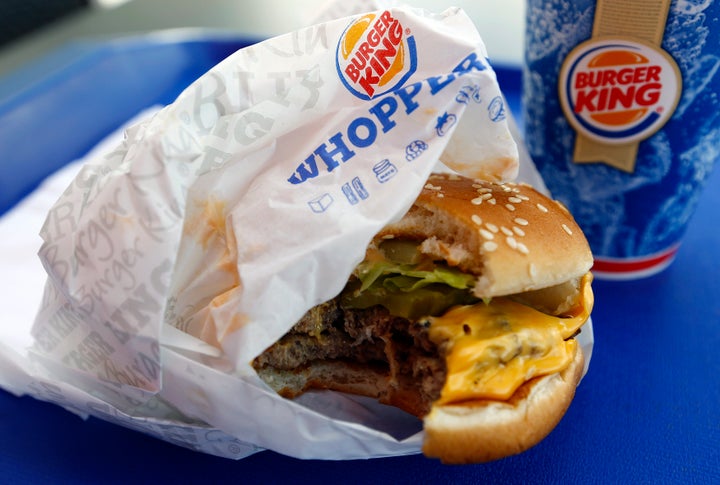The next time you chomp down on a cheeseburger from a drive-through, you might want to consider that the paper it is wrapped in could be bad for you.
That’s because, according to new research, such wrappers commonly contain the toxins perfluorinated chemicals (PFCs) or polyfluoroalkyl and perfluoroalkyl substances (PFASs). Scientists have linked these chemicals to cancer, developmental issues, a weakened immune system and other health issues.
The recent testing of 400 food and beverage containers from 27 fast food chains across the country identified detectable levels of fluorine ― which scientists say is a likely indicator of PFASs or PFCs ― in about 40 percent of the samples, according to a paper published Wednesday in the Environmental Science & Technology Letters journal. (Fluorine is used in food packaging to resist unsightly grease stains.)
Some types of packaging analyzed in the testing conducted by a group of scientists from both federal and state regulators, nonprofit groups and academic organizations had higher levels of fluorine than others.
Fifty-six percent of the dessert and bread wrappers tested had detectable levels of the chemical, while 38 percent of sandwich and burger wrappers and 20 percent of paperboard containers did as well. None of the paper cups analyzed came back with detectable levels of fluorine.
A subsection of the samples was specifically tested for the presence of PFASs, which were identified in 70 percent of them. Additionally, 20 percent of the subsection had detectable levels of PFOA, a synthetic and potentially carcinogenic PFC previously used to make Teflon.
The study did not test for these chemicals in the food itself, but previous research has shown that the chemicals in food wrapping can migrate from the wrapper to the food. The study noted that hotter, greasier foods ― like many of the items sold at fast food restaurants ― are the most likely sources of chemical-leaching.

Dr. Arlene Blum, the executive director of the Green Science Policy Institute and one of the study’s authors, pointed to microwave popcorn as an example of this sort of migration.
“You’re popping popcorn in a bag with chemicals on the inside, and then it gets hot and the corn bounces all around,” Blum told The Huffington Post. “It makes sense that the chemicals would transfer to the popcorn.”
“I think the prudent thing to do is to reduce your exposure when you can.”
- Dr. Arlene Blum
There are important caveats to the research, that are worth considering.
These chemicals aren’t limited to food wrappers ― they’ve also been used in many consumer products like non-stick pots and pans, carpeting, outdoor clothing and other items intended to repel soil, grease or water.
And the existing research about how dangerous they may be is not limited to exposure through food wrappers. The chemicals are so ubiquitous, they’re also turning up in our water.
A separate study from Harvard University researchers published last year found that the drinking water supplies of about 6 million people contained amounts of PFASs exceeding the Environmental Protection Agency’s health advisory level. The impacted communities were found in 33 states.
Because exposure to the chemicals can happen in so many different ways, Blum admitted it is difficult to isolate the precise danger of exposure through food wrappers.
Still, she noted, some scientists and environmentalists have argued that there is no safe level of additional exposure to the chemicals.
“I think the prudent thing to do is to reduce your exposure when you can,” Blum said. “You can’t get it to zero, but you can reduce it.”
Manufacturers say they’ve phased out the use of these chemicals, but environmentalists still aren’t convinced.
The Food and Drug Administration has already banned PFOA from food packaging but continues to allow the use of similar “next generation” PFCs that are similar in chemical composition but that manufacturers claim are safer. Environmentalists, however, remain skeptical that these alternative chemicals do less harm.
Advocacy organizations like the Environmental Working Group, which collaborated on the new study, argue these PFCs have not yet been properly tested for safety and that the FDA has failed to step in to protect consumers.
In a Wednesday paper accompanying the study, the EWG called for fast food companies to stop using packaging that contains PFCs.
As Blum noted, since some of the samples included in the analysis did not contain any such chemicals, she is hopeful that others will soon follow the lead of companies that are exercising greater caution.
“Given the potential for harm, it seems reasonable for these companies to move to safer alternatives,” Blum added. “We believe it can happen.”
―-
Joseph Erbentraut covers promising innovations and challenges in the areas of food and water. Follow Erbentraut on Twitter at @robojojo. Tips? Email joseph.erbentraut@huffingtonpost.com.